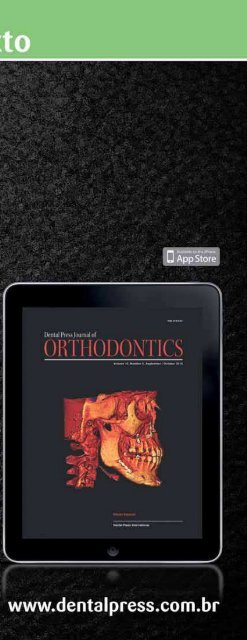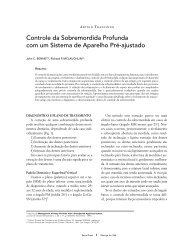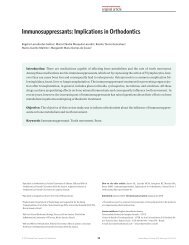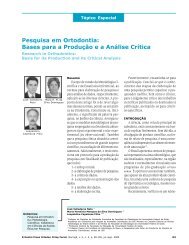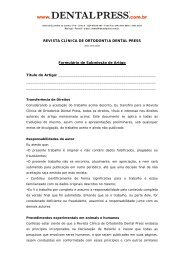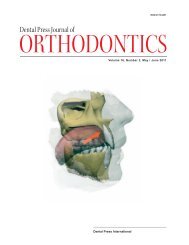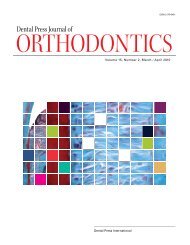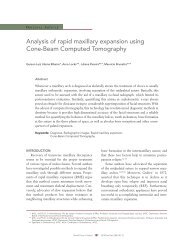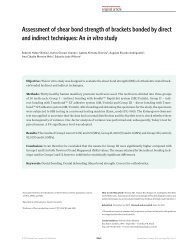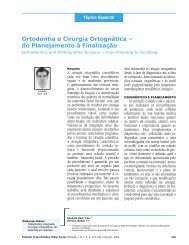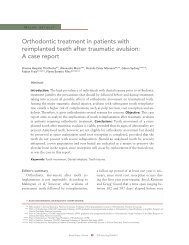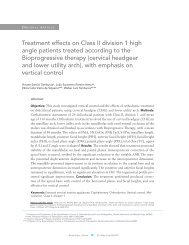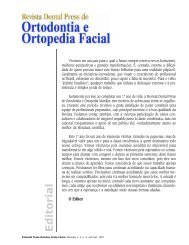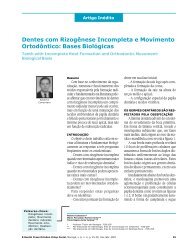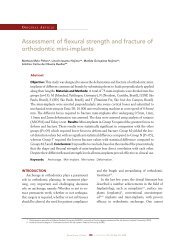Dental Press
Dental Press
Dental Press
You also want an ePaper? Increase the reach of your titles
YUMPU automatically turns print PDFs into web optimized ePapers that Google loves.
Consolaro Alocation in which it acted, there may be a resultant offorces in the apical third of the tooth root with ruptureof the vascular and nerve bundle that enters the pulp.An example of dental traumatism is the concussion,with no clinically detected mobility and pain, if any,is easily controlled with common analgesics, lastingseveral hours or even 2 to 3 days. 2,3 Apparently, thetooth gets back to normal, but within time the pulpmay show its damage with the presence of calciummetamorphosis of the pulp or pulp aseptic necrosis,both clinically revealed by coronary darkening in anapparently healthy tooth.In occlusal trauma the death of cell and the structuralrupture are minimized by the quick length andrepetitiveness of the process, although it is for a longtime. In this case, there is no structural damage tovascular and nervous bundle of pulp, nor fast agingof the pulp. The periodontal lesions are light andsubtle. The periodontal structure must be acknowledgedas an example of an organization to receivethe strong forces of chewing. The periodontal fibersare organized in a space with an average thicknessof 0.25 mm, but even so during chewing the teeth donot touch the bone.In the orthodontic movement the forces appliedto the tooth structure, even the most intense, graduallydisappear in the surrounding tissues. The plasticityof the connective tissue of the periodontal ligament,plus the deflection capacity of the bone crestand the rotation that happens in the tooth socketpromote a slow and gradual adaptation of the surroundingtissues. The orthodontic movement is limitedto a maximum of 0.9 mm at the crown during thefirst hours 1 providing no conditions for the structuralrupture of vessels and nerves to happen.There should not be a comparison among thetissue effects induced by dental traumatism, occlusaland orthodontic movement, as they are differentsituations. In the apical third of root the inducedorthodontic tooth movement is confined practicallyto the compression of the periodontal ligament,because the bone deflection in the periapical boneis much smaller and the tooth hinge axis is nearthe apex. The forces are absorbed and dissipatedslowly, without rupturing vessels. Small movementsare naturally absorbed by fibrous and elastic connectivetissue.Another important information concerns the durationin which the orthodontic forces are active: 2 to4 days. After this time these forces are dissipated andthe reorganization of the periodontal structures beginswith resorption of the periodontal bone surface,cell migration for reorganization with the productionof new collagen fibers. 1 After 15 to 21 days the periodontalligament and other structures are ready fora new cycle of events by the reactivation of the orthodonticappliance. In other words, the induced toothmovement is achieved in cycles of 15 to 21 days, thetooth does not move all the time. In the orthodonticmovement forces are mitigated by the collagen andelastic fibers, without damaging the structures thatcarry blood and sensitivity to the pulp.With each activation period of orthodontic appliances— from 15 to 21 days — the periodontaltissues reorganize themselves and return to normal.The ultimate effects of orthodontic treatment on thestructures and position of teeth are the sum of all cyclesfrom 15 to 21 days. The forces and the effectswere not continuous and unceasing. Sometimes thequestion is: when there is rotation of the tooth aroundits long axis, as in giroversion, vascular and nervebundles get twisted around themselves, does it notcompromise the blood supply to the pulp? No, theyare not twisted, because the tissues reorganize themselvesin each period of 15 to 21 days, they return totheir normal position and relationship. When the newcycle of movement is established by a new activation,the vessels and nerves are in normal relationship withno change in their shape. Tissues constantly renewits structures, remodel and adapt themselves well tonew positions and structural relationships.Consolaro, 4 in his investigation of Masters in 2005,and Massaro et al 9 in 2009, examined microscopicallythe pulp of 49 first molars of rats under inducedtooth movement after 1, 2, 3, 4, 5, 6 and 7 days. Resorptionwas detected in the external surfaces of theroot, indicating the efficiency of the applied forces.However, no morphological changes was detectedin the pulp tissues (Figs 1-6).Synopsis for endodontists of the inducedtooth movement, or does intense force increasethe chance of pulpal necrosis by orthodonticmovement?© 2011 <strong>Dental</strong> <strong>Press</strong> Endodontics 15<strong>Dental</strong> <strong>Press</strong> Endod. 2011 apr-june;1(1):14-20


